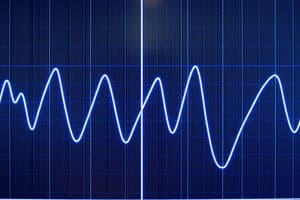Podcast
Questions and Answers
What is the purpose of a seismic measuring instrument?
What is the purpose of a seismic measuring instrument?
- To predict the time of an earthquake
- To detect and measure movements during an earthquake (correct)
- To record atmospheric pressure changes
- To assess the structural integrity of buildings
What does the term 'tsunami' refer to in Japanese?
What does the term 'tsunami' refer to in Japanese?
- Wave generated by earthquakes
- Undersea volcanic eruption
- Storm surge from the ocean
- Big wave in the port (correct)
Which of the following best describes a volcano?
Which of the following best describes a volcano?
- A type of earthquake detector
- A large underwater trench
- A flat land that erupts gases and ash
- A mountain with a crater for volcanic activity (correct)
Which phenomenon is primarily associated with undersea earthquakes?
Which phenomenon is primarily associated with undersea earthquakes?
Which statement about seismic instruments is incorrect?
Which statement about seismic instruments is incorrect?
Flashcards are hidden until you start studying
Study Notes
Earthquake Measurement Instruments
- Instrument detects and measures the intensity, direction, and duration of earthquake movements.
- Provides crucial data for understanding seismic activity and assessing risks.
Tsunami Terminology
- "Tsunami" derives from a Japanese term meaning "big wave in the port."
- Tsunamis are typically generated by undersea earthquakes affecting coastal areas.
Volcanic Features
- A volcano is a mountain or hill, usually conical in shape.
- Characterized by a crater or vent that erupts lava, rock fragments, hot vapor, and gases.
- Volcanic activity plays a significant role in geological processes and can impact surrounding ecosystems.
Studying That Suits You
Use AI to generate personalized quizzes and flashcards to suit your learning preferences.




